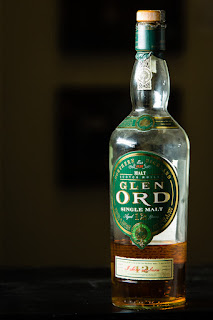At least not in the US, Europe, Africa, South America, Antarctica and most of Asia.
I rarely swear at the computer screen while writing these reviews. After all, I'm drinking good whisky - that generally translates into a good mood.
But, as I was reacquainting myself with this old bottle of Glen Ord I unearthed from the back of liquor closet, sighing happily with each sip, I found myself damning those black hearted bastards at Diageo with vehemence I would normally reserve for some worthless, slack-jawed, jackass who just cut me off in traffic.
Those f$%#!!'s took my whisky away.
Yes, those blackguards at Diageo, the monstrous conglomerate that owns Glen Ord and several other distilleries, including Lagavulin and so help me God they'd better not pull this crap with that single malt, have ended the distillery editions of Glen Ord. The whisky barely continues as a single malt as "The Singleton of Glen Ord" in 12- and 15-year-old expressions, but only at the distillery itself, and in Japan.
The other approximately 6.96 billion of us are S-O-L (shit outta luck).
If you look really hard (say, at the Whisky Exchange site in the UK) you might find a retailer with a small hoard some old stock of the Glen Ord 12-year-old. That bottle will cost about $100 before shipping, which is a damn sight more than my old bottle cost me back in the day.
The rest of the distillery's production presumably goes into blended Scotches, for example, the various Johnny Walker blends (also owned by Diageo). I hope not too much of it ends up in Johnny Walker Red, as that would be a mighty sin.
And what makes this so sad is that this is a really excellent whisky. Glen Ord is a sherry cask aged Highland whisky. While it is similar to the Macallan and Glen Farclas whiskies I have previously reviewed, it does have a different character.
The Glen Ord 12 (RIP) was bottled at 80 proof (40% abv), which is pretty much at sipping strength. I prefer it with a small (very small) splash of water, as that opens up the aromas and flavor for me.
The aroma is sweet sherry with heather notes with a slight subtle hint of smoke. The spirit has a lovely amber color with a tinge of red.
"I shine, not burn" is the motto on the bottle, and that's exactly how it drinks. It start out with smooth sweetness of sherry, heather and honey. About midway through, some fire, a little spice and a suggestion of smoke that rapidly disappears enter the flavor mix. It all fades pleasantly away, leaving your fast buds demanding more.
Is it worth $100 and international shipping costs? That's a tough call. I easily like it as much as the Macallan 12, probably a little bit more. But $40 plus more? Damn Diageo for making me have to think about that.
If you are traveling, and do get a chance to taste the Glen Ord 12, then I recommend you leap at it. Because if you're one of the S-O-L 6.96 billion, it might be a once-in-a-lifetime opportunity.
(PS - let me know if you're going to be visiting the Glen Ord distillery. I might need a care package.)

